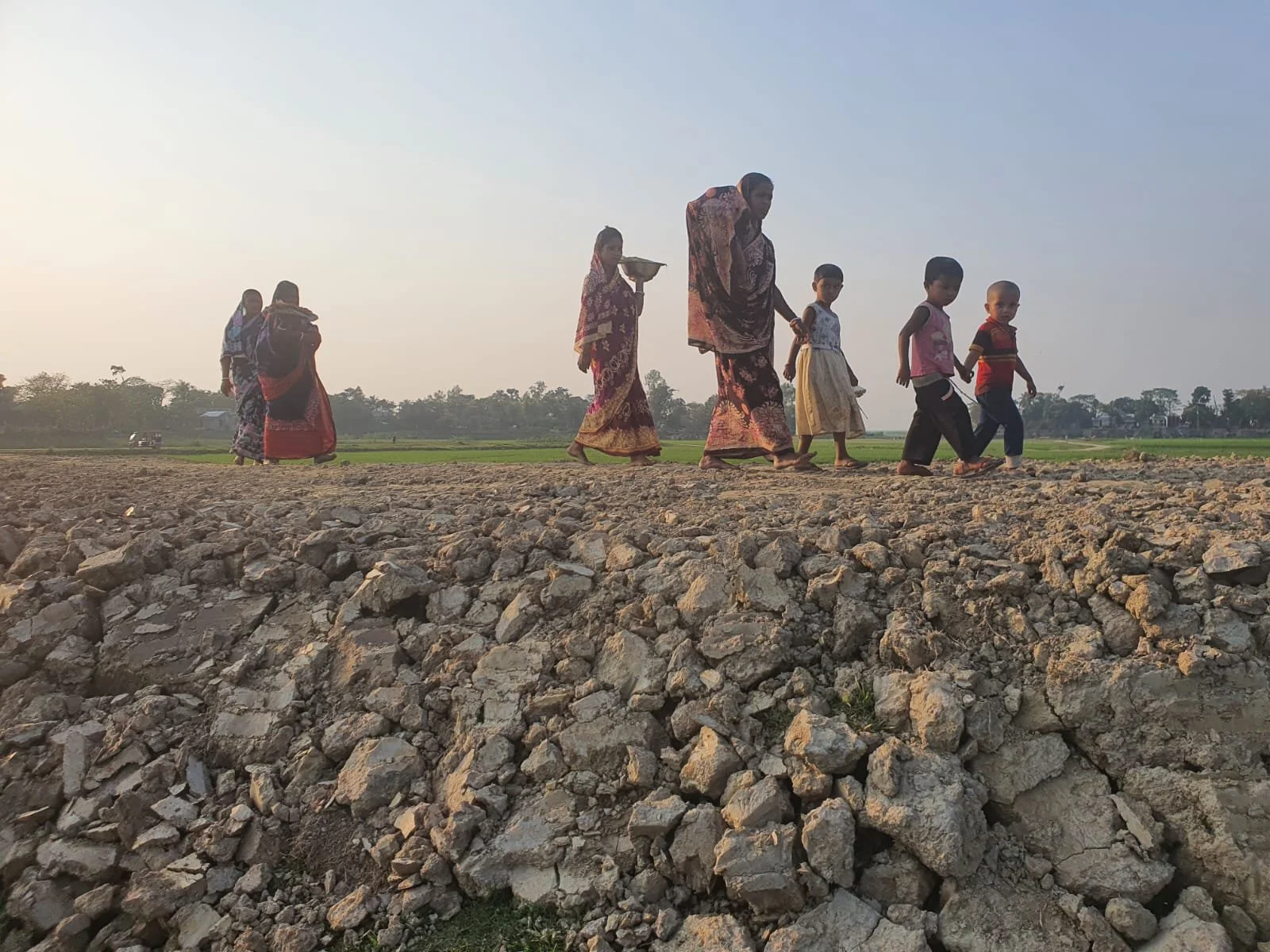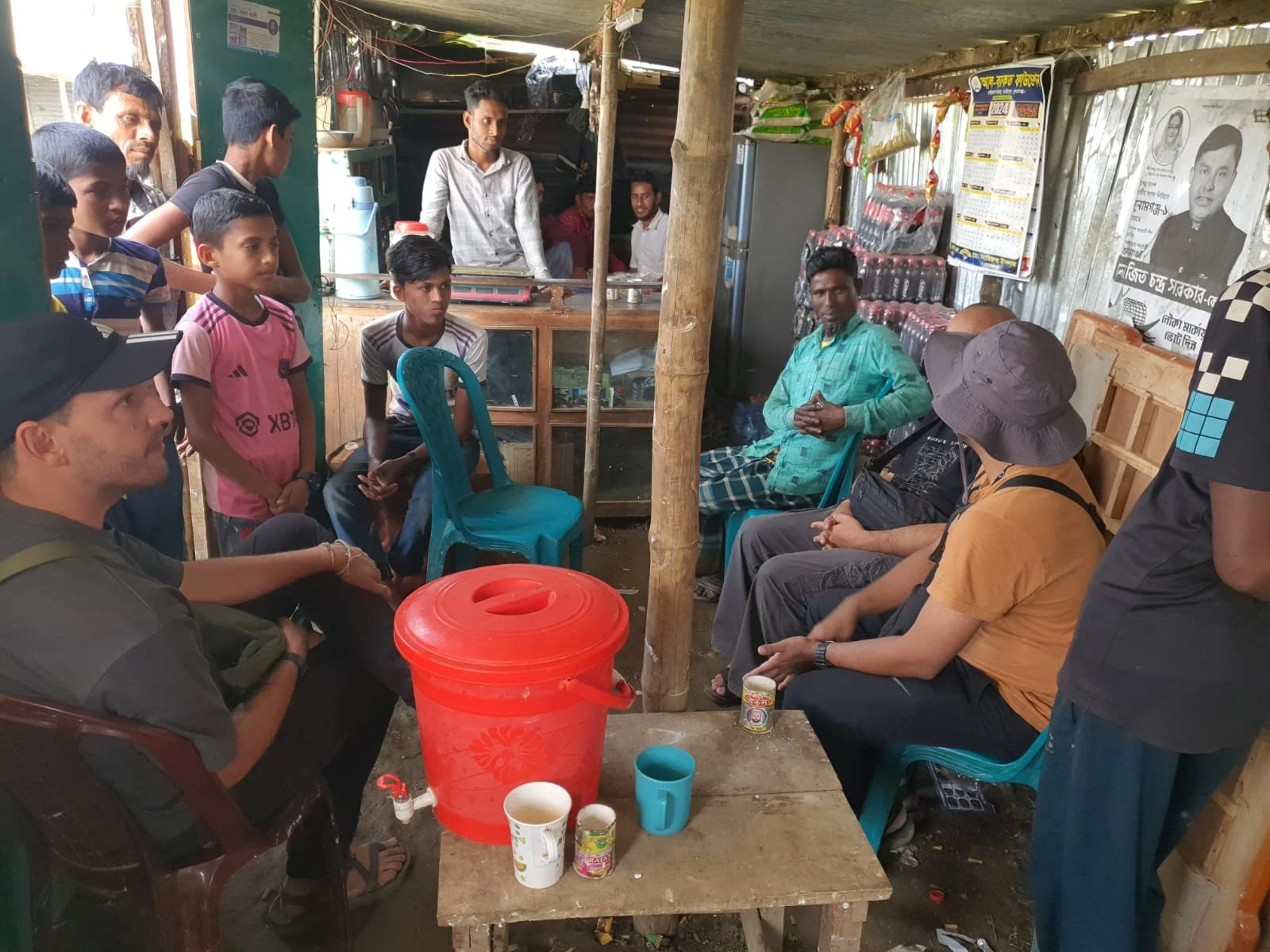Beyond Borders: New Collaboration between Indonesia and Bangladesh
By Adam Miller and Abrar Ahmad, with input from Novi Sagita and Miftah Zam Achid
This February, I had the privilege of visiting Abrar Ahmad (Planet Indonesia’s Technical Advisor for Terrestrial Conservation) in Bangladesh with senior management members Novia Sagita (CEO) and Miftah (CPO).
Our trip started in the bustling capital city of Dhaka, Bangladesh. Considered the 7th most populated city in the world, this mega-city can host upward of 22 million people with an average density of over 1,200 individuals per kilometer.
Abrar and his family welcomed us with open arms and took us around this metropolis on an epic culinary adventure on day one. We tried various meat dishes cooked in clay pots for hours, rich vegetable and fish curries, and more dal (lentils) than anyone could dream of.
On the second day, the real adventure began. We jumped on a bus at midnight to start the 8-hour journey to Tanguar Haor one of the largest ‘haors’ of Bangladesh and our destination. ‘Haor’ in the Bengali language means a bowl-shaped depression inundated for 7 to 8 months of the year caused by runoff from rivers and canals after the monsoon season. During the dry season, it turns into rich, fertile grasslands with sporadic beels where some water gets trapped even after flood waters recede. According to the Bangladesh government estimates, there are at least 373 haors that cover 1.99 million hectares and support nearly 20 million people living in the Northeastern parts of the country1.
Tanguar Hoar, located at the foothills of the Meghalaya state of India, hosts a unique ecosystem covering 2,800 hectares (6,900 acres) of wetlands. As one of the largest wetland ecosystems in the country, the Tanguar Haor was also once very rich in fish biodiversity and fishery resources, supporting the livelihoods of tens of thousands of fishermen. Considered one of the six principal “Mother Stocks” in Bangladesh, this area facilitates the nursery grounds for local and indigenous fish species that support fish populations in surrounding rivers and canals 2. According to researchers Doz (1997), Nuruzzaman (1997), and Khan (1997), Tanguar Haor was once home to approximately 141 fish species, representing nearly half of the 260 freshwater fish species found in Bangladesh. Moreover, this wetland ecosystem hosts 23 of the 55 nationally threatened and endemic fish species, of which 17 were found only in Tanguar Haor3.
Drone shot of the Haor landscape during the peak of the dry season in February. The landscape turns into a network or rivers, canals, and isolated water bodies known as ‘beels’ during the dry season. Starting April this landscape becomes completely inundated and turns into an inland sea.
According to the IUCN, the Tanguar Haor wetland is used by roughly 50,000-75,000 birds from 206 migratory bird species annually! However, the importance of this area stretches far beyond biodiversity as it supports more than 60,000 people from 88 surrounding villages and provides more than USD 3.8 million worth of regulating services through flood protection for millions of people living downstream. Furthermore, the area contributes to Bangladesh's food production and security by producing thousands of tons of fish and paddy annually4.
Novi, Miftah, and myself couldn’t have been more excited to support Abrar on this scoping mission, to meet with communities inside Tanguar Haor to gain insights into the struggle they faced and the solutions they had.
After a grueling and bumpy 8-hour bus ride, we reached the district city of Sunamganj early in the morning. Right after getting off the bus, we jumped on the houseboat and began our journey into the heart of this vital wetland freshwater ecosystem. As February was still the dry season, it took us another 10+ hours navigating through the rivers and the canals to reach a village close to the Tanguar Hoar wetland called Jagdishpur. That night, our stomachs full of rice and fish curry, we met with locals at a nearby tea stall. Over steaming black tea, they explained the challenges faced by farmers and fishermen, as well as women and children in their villages.
The government’s district administration manages the Haor region's fisheries by auctioning fishing permits for selected areas. Local elites often overbid fishermen groups and hire people who are ‘loyal’ to them to catch fish in these areas in exchange for one-third of the revenue from the catch. Although permits regulate the number of people who can fish, it creates a classic case of the ‘tragedy of commons’ as permit holders, and their hired fishermen have it in their best interest to catch everything since they do not know if they will get permits next year.
Local people use a recently raised embankment with the support of government funds. These embankments protect villages and their agricultural lands from initial floodwaters. However, as floodwaters recede, many of these embankments erode and break down, requiring continuous repair.
This combination of uncertainty from short-term annual permits and nepotism creates a mentality of maximizing catch, eroding fish stocks consistently throughout the Haor regions. On the other hand, most people depend on growing paddy on the fertile soils that appear as floodwaters recede during the dry season (post-October). However, unseasonal and unpredictable rains can cause floods that drown the low-lying paddy fields and put farmers in significant debt that can linger for years.
Locals also explained that most children in their village would not complete their secondary education due to the lack of schools accessible to their village. According to the locals, only a handful of ‘well-off’ families with relatives living in nearby cities would send their children to complete secondary education. The locals painted a similar picture about the state of their public health services which affects mainly children and women. While children suffer from waterborne diseases, child-bearing women have to travel on boats or motorcycles for hours to reach the nearest clinics to give delivery. Talking to the community members that night gave us context of the daily challenges communities face in this landscape.
The next day,
we woke early to rice cooked with lentils called ‘khichuri’, boiled egg curry with potatoes, and fried eggplants for breakfast. Post-breakfast, we continued to a more isolated village called Chilani where around 100 families are crammed into a tiny piece of high ground in the middle of the Tanguar Hoar landscape. Like many other villages in the Haor region, 7-8 months of the year, community members need to rely on boats as the only mode of transport.
As we made our way to a small tea stall through the village, we were met with great excitement by community members in this village. At the tea stall, we met with village representatives to tell us their stories of living in one of the most extensive wetlands in Bangladesh. Like the village the night before, people in this village explained that lack of access to equitable rights to fish coupled with early floods during the dry season were the most pressing issues facing their livelihoods. Some people pointed out that it was becoming harder to catch fish and that they rather preferred farming paddy as it was a better livelihood option.
Regarding education and basic public health services, one community member explained that their village was the most neglected in Bangladesh! This was echoed by one of the two teachers responsible for teaching all the students in this village. He explained that in 2023, around 50 students completed their curriculum, but only three continued their secondary education at the nearby district city.
Having spent close to an hour listening to the community members explain their issues and challenges, it was clear to us that communities inhabiting the Tanguar Hoar landscape faced many of the same challenges that are addressed through Planet Indonesia’s core model and community-led programs that place communities at the center of the decision-making processes, shaping their socio-economic and environmental future.
Speaking with community members at a tea stall in the Chilani village. People at this village were very enthusiastic about speaking about their daily challenges and experiences.
That afternoon, we began our boat journey back to the district city of Sunamganj to catch another night bus and return to Dhaka. Although it was just a brief trip into this globally important ecosystem, the challenges communities faced were clear. Access to basic social and economic services is largely lacking for communities, and livelihoods are threatened by eroding fish stocks arising from ineffective top-down fisheries management practices and changing weather patterns causing early floods leading to crop loss for the entire year.
Planet Indonesia - USA and Yayasan Planet Indonesia are beyond excited to support Abrar in his journey to create a Bangladesh-based NGO to tackle these problems.
While it is clear he will face great adversity, we know Abrar and the team he is assembling are up for the challenge. Putting fishers and farmers at the center of the governance of this wetland area is one thing we all agreed upon. Abrar has taken inspiration from the Planet Indonesia core model and his last four years working with us. He is now adapting and contextualizing the approach we have scaled across Indonesia to Bangladesh.
References:
1Government of Bangladesh. (2012). Report on Bangladesh Haor and Wetland Development.
2Alam, M. G., Khan, S., & Doz, H. (2015). Biodiversity and conservation of Tanguar Haor: A Ramsar site of Bangladesh concerning global climate change. Journal of Environmental Science and Natural Resources, 8(2), 1-6.
3Same as above.
4International Union for Conservation of Nature (IUCN). (2015). Conservation of Tanguar Haor: Biodiversity, livelihood, and climate change. Retrieved from https://portals.iucn.org/library/sites/library/files/documents/2012-021.pdf.
If you have any questions please reach out via admin@planetindonesia.org. Sign up for our newsletter and follow us on our social media Facebook here, Instagram here, and LinkedIn here to get timely updates on our activities, an insider’s look into the lives of front-line conservationists, and ongoing programs.









